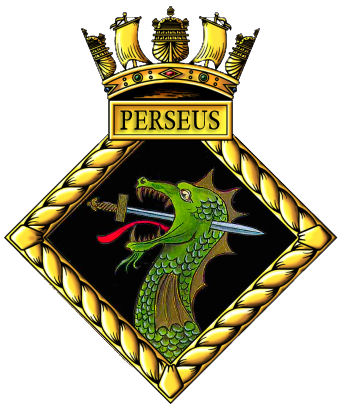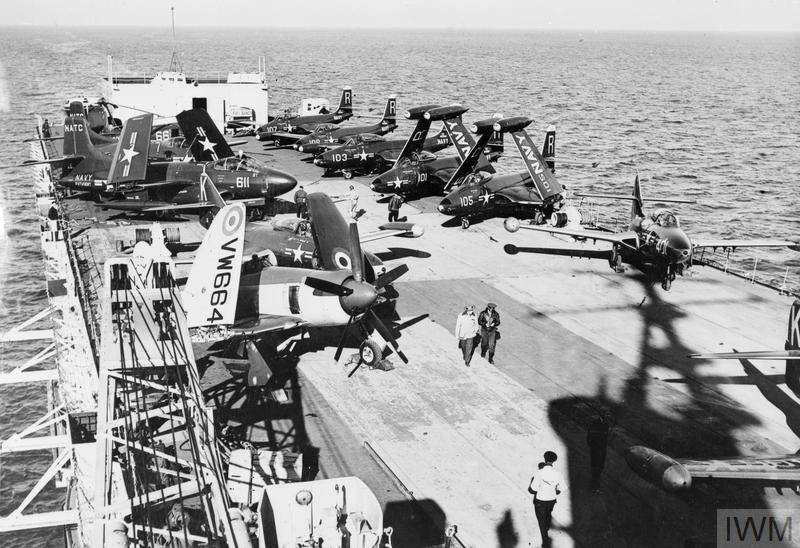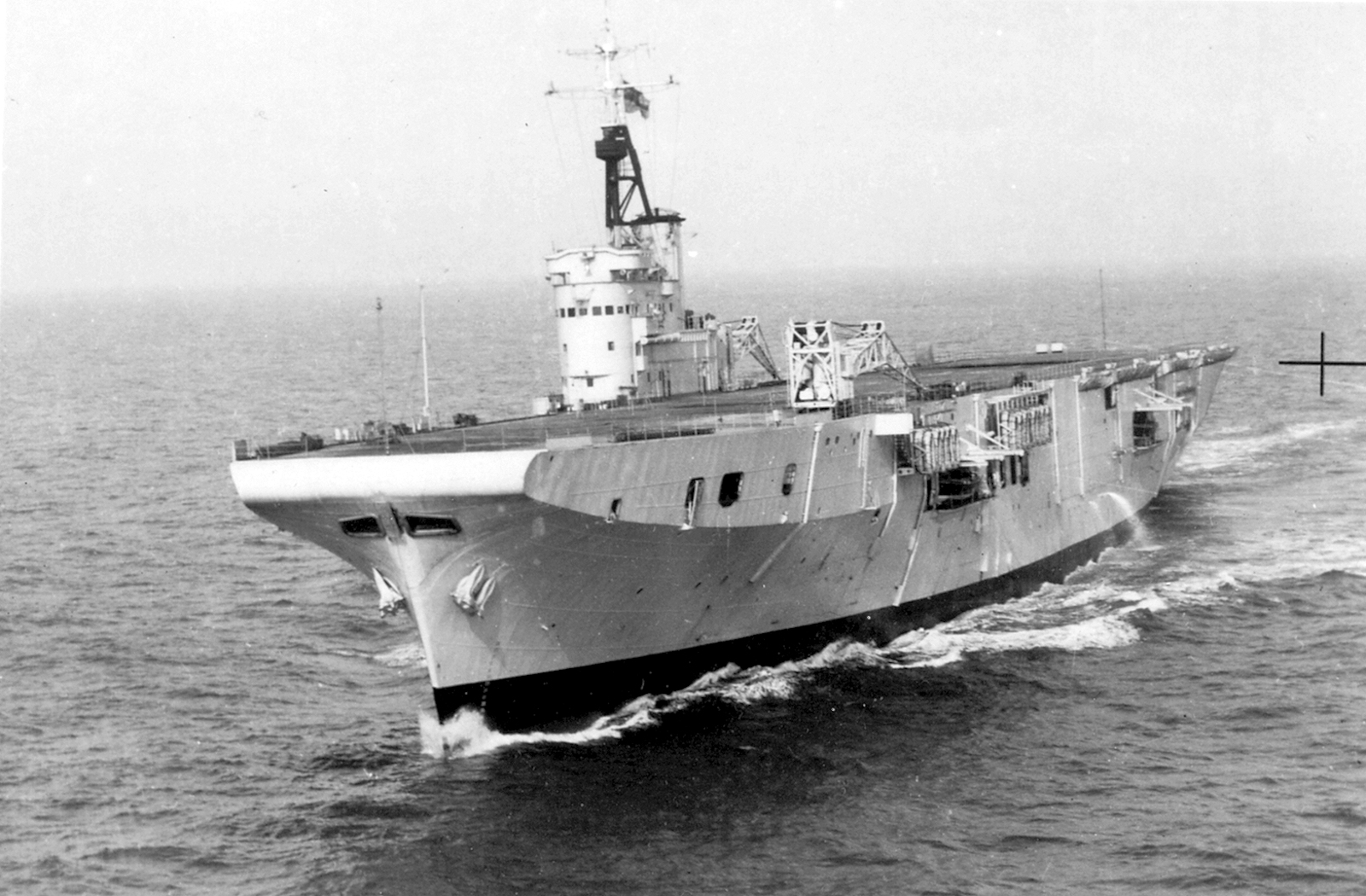Aircraft Maintenance Carrier

Battle Honours
None.
Specifications
Builder: Vickers Armstrong, Newcastle, United Kingdom
Displacement: 18,330 tons
Length: 695 ft
Beam: 80 ft 4 int
Draught: 23 ft
Speed: 25 Knots
Crew complement: 1,076
Commanding Officers
Captain G. R. Deverell 17 Apr 1945
Commodore H. S. Murray-Smith (COMAT) 14 Jan 1946
Commander R. E. Gunston
Commander E. H. Dyke
Captain H. A. Traill, CBE
Captain P. C. S. T. Carey
Related items
None
Reminiscences
None
H.M.S. PERSEUS
Read aloud

History
Laid down as a Colossus class Light Fleet Aircraft Carrier on June 1st 1942 at Vickers Armstrong, Newcastle and launched 26 March 1944. Her designation was changed, along with that of her sister ship PIONEER, to Aircraft Maintenance Carrier while she was being completed. The aft end of her flight deck was obstructed and she was built without catapults so no flying operations could be undertaken; all aircraft had to come aboard from lighters using the ship's cranes.
Originally to be named HMS EDGAR; this was changed to PERSEUS in July 1944 when the decision was made to repurpose her as an aircraft maintenance carrier. she was commissioned on October 19th 1945 as HMS PERSEUS, the sixth ship to bear the name.
Allocated to the British Pacific Fleet
On completion of her sea trials and defect rectification at her builder’s yard she began a short work-up in preparation for deployment to join the British Pacific Fleet (BPF). Arriving at RNAMY Belfast in early November work began to embark air stores, equipment and spare airframes for ferrying to Australia. PERSEUS sailed on her maiden voyage to Sydney, Australia, leaving the UK on November 16th 1945. She called at Trincomalee, Singapore and Freemantle before arriving a Sydney on December 22nd 1945 carrying a cargo of Seafires and Fireflies for service with the BPF. After disembarking her ferry load at Prymont for delivery to RNAS Bankstown she awaited further orders.
With the war over there was no requirement for two maintenance carriers in theatre so it was decided that PERSEUS was to replace PIONEER and Commodore Air Train (COMAT), Commodore H. S. Murray-Smith transferred his Broad Pennant to her on January 14th. Captain G. R. Deverell, commanding officer of PERSEUS assumed command of PIONEER on this date.
At 0800 at January 31st while moored off Kirribilli Point an aircraft lighter alongside exploded in a fireball sending flames 50 feet in the air and seriously injured three crewmen. Petty Officer E. Martin, Able Seaman L. Sanford, Stoker A. Ashton all received serious burns. The ship was undamaged and sailed the same day for Brisbane. She Dumped 12 'Lend-Lease' Avenger and Hellcats on passage.
Beginning on February 24th a mix of British and American aircraft and crated aircraft engines were loaded at Brett’s Wharf, Hamilton. These aircraft came from the Royal Naval Aircraft Repair Yard at Archerfield and were delivered to the ship on specialist trailers or were towed on their own wheels. Reports say she crammed 115 airframes onboard and 130 aero engines; of this load 60 ‘Lend-Lease' Corsair and Hellcats were to be dumped at sea. PERSEUS sailed for Sydney on Tuesday the 26th. On completion of the disposal at sea task the Air Train was to be disbanded and COMAT struck his broad pennant on February 28th 1946 marking the end of Air Train operations.
PERSEUS arrived back at Sydney on March 5th, securing at No.14 berth Pyrmont. The carrier was now deemed to be surplus to requirements and would return to the UK and part of her crew complement was drafted to RN Barracks Sydney for reassignment. Work next turned to the loading of airframes and equipment, mostly British, stores and passengers; she sailed on March 2nd calling at Melbourne on the 24th, sailing for Fremantle on the 27th, calling there on April 1st before proceeding to Trincomalee. In addition to airframes and air stores she also carried a large consignment of food donated by the Australian people, and RN personnel travelling home for demob were embarked along the way.
Catapult trial ship
PERSEUS arrived at Rosyth on May 17rh 1946 and after unloading and destoring she was transferred to the reserve fleet effective from June 1st 1946. Command passed to Commander R. E. Gunston, her executive officer. He in turn was relieved by Commander E. H. Dyke on October 4th 1948.

The ship remained in the reserve until starting a major refit during 1949 - 51 at Rosyth Dockyard, In the absence of a dedicated trials carrier she had been chosen to conduct sea trials of the prototype BXS.1 slotted-tube steam catapult the brainchild of Commander Colin C Mitchell RNVR. Captain H. A. Traill, CBE assumed command on June 22nd 1950.
The catapult was installed in a new structure on the deck of the carrier early in 1951. This catapult used low pressure, low temperature steam and required 20 minutes between aircraft launches. PERSEUS began the trials in the spring of 1951 at first launching wheeled dead-loads of gradually increasing weight, before launching surplus aircraft with their wings removed but no engine power, followed by launches with the engines at full power. The initial testing phase over, manned launches began using Seafire F.47 VP460 and two Sea Fury Mk.X TF922 and TF955 embarked at RNAMY Belfast.
At the start of 1952 PERSEUS sailed for America to demonstrate the catapult for the US navy. She arrived in Philadelphia Naval Shipyard on January 14th to have her catapult calibrated before arriving at Norfolk on February 11th to begin her demonstration. The steam catapult made 127 manned aircraft launches of British and American aircraft, including Douglas F3D Skyknights, Grumman F9F Panthers, and McDonnell F2H Banshees. PERSEUS was not an operational carrier so the aircraft could not land-on, they had to be lifted on to the deck by crane before the days' trials, flying ashore to land after launch.
At the U.S. Navy’s request further trials were added to test claims that the BXS.1 could successfully operate using the American 550psi high-pressure steam system. To facilitate this the USS Eugene A. Greene (DD 711) was moored alongside and supplied steam to the catapult. The catapult successfully demonstrated that it could provide the acceleration needed for launching high-performance jets.
Reclassified as a Ferry Carrier
PERSEUS arrived back at Portsmouth on March 21st 1952 to have the catapult removed. While in the dockyard she also had all of her flight deck structures removed, and additional aircraft mooring points installed across the whole deck to emerge as an Aircraft Ferry Carrier.

Since the outbreak of the Korean War in June 1950 the supply of reserve airframes to support Commonwealth naval air operations had been handled by the Maintenance Carrier UNICORN. She operated between Royal Naval Air Station Sembawang in Singapore and Royal Australian Air Force Station Iwakuni in Japan with occasional return trips to the UK. In December 1952 the aircraft ferry task between the UK and Singapore passed to PERSEUS freeing UNICORN to focus on the Sembawang to Iwakuni ferry role. Captain P. C. S. T. Carey arrived to take command on December 5th 1952.
First ferry load: this was embarked between December 4th and the 12th 1952 and included 10 Whirlwind HAS.21s of 848 NAS, the Royal Navy’s first Transport Support Squadron, for passage to RNAS Sembawang, and 3 Dragonfly helicopters for AHU Hal Far. Also, her flight deck was packed with crated stores and military vehicles. A number of coaches were also carried for onward delivery to Iwakuni; these were for the use of Commonwealth personnel on leave in Japan.
PERSEUS arrived at Malta on December 17th to unload and then proceeded to Trincomalee to deliver part of her load of vehicles. She reached Singapore on January 8th 1953. A week later she embarked 2 Sea Fury, 1 Sea Otter & 1 Dragonfly and sailed for the USA to collect a consignment of aircraft supplied to Britain under the Mutual Defence Aid Programme (MDAP). At Norfolk Naval Operating Base, Virginia she embarked 13 Douglas Skyraider AEW1 on January 26th. She next sailed for Malta where she collected 1 Sea Fury & 8 Fireflies from AHU Hal Far on February 2nd. PERSEUS arrived back at Portsmouth on February 18th, proceeding to Glasgow she unloaded the Skyraiders at King George V Dock for delivery to RNAMY Abbotsinch AHU on February 19th.
Second ferry load: PERSEUS acted as a training ship when she sailed for America again on March 6th 1953, she carried 200 reservists drawn from all of the RNVR Divisions on board. She arrived at Norfolk on March 13th to collect another batch of 11 Skyraider AEW1 aircraft and 36 Avenger TBM-3E. She arrived at King George V Dock, Glasgow on March 30th to unload her aircraft; these were delivered by road to RNAMY Abbotsinch AHU.
Third ferry load: PERSEUS arrived back at Norfolk on May 4th to embark a further 53 Avenger TBM-3E and 2 Skyraider AEW1. She arrived at King George V Dock, Glasgow on May 15th, the aircraft arrived at RNAMY Abbotsinch AHU on the 19th. This completed the delivery of Avenger and Skyraider aircraft supplied under the MDAP.
In June 1953 PERSEUS embarked a party from the Aeroplane and Armament Experimental Establishment at Boscombe Down, to perform carrier trials of the Westland S-51 Dragonfly HR5, beginning on June 12th.
Forth ferry load: PERSEUS began preparation for a second voyage to Singapore in August; loading beginning on August 15th and included 2 Dragonfly helicopters for AHU Hal Far. 9 Sea Furies and a final consignment of 2 Dragonflies for the AHU at Sembawang. The ship arrived at Singapore on September 4th 1953. For the return trip she embarked 2 Sea Fury, 7 Fireflies & 1 Dragonfly from AHU Sembawang on October 5th before sailing for Malta to collect 5 Fireflies and 1 Skyraider from AHU Hal Far on October 27 - 30th. The ship arrived back at Portsmouth on November 9th.
Fifth ferry load: PERSEUS was to make a third and final round trip to Singapore in 1954. On April 13th 1954 she embarked 12 Sea Furies and sailed for Sembawang. On arrival in Singapore these were off loaded to AHU Sembawang on May 26th.
TheKorean War had ended the previous July but Commonwealth carriers maintained a presence of the Korean peninsula until May 1954 when HMAS SYDNEY ended the last patrol by a Commonwealth carrier. The AHU at Iwakuni, Japan was evacuated by UNICORN and the stock of reserve airframes arrived at Sembawang on May 18th; PERSEUS would now embark and ferry home many of these airframes. The ferry load included 12 Sea Fury & 2 Fireflies; she sailed for Malta on June 5th where she embarked 2 Fireflies from AHU Hal Far on July2nd. PERSEUS arrived back at Portsmouth on July 12th 1954.
Return to the reserve fleet
In 1955 PERSEUS received a second refit but was paid off and transferred to operational reserve status on completion. PERSEUS was finally put up for disposal in 1957, being sold May 6th 1958 to Smith & Houston for Breaking at Port Glasgow.
Last modified: 23 February 2023
Primary information sources
Additional sources:


Comments (0)